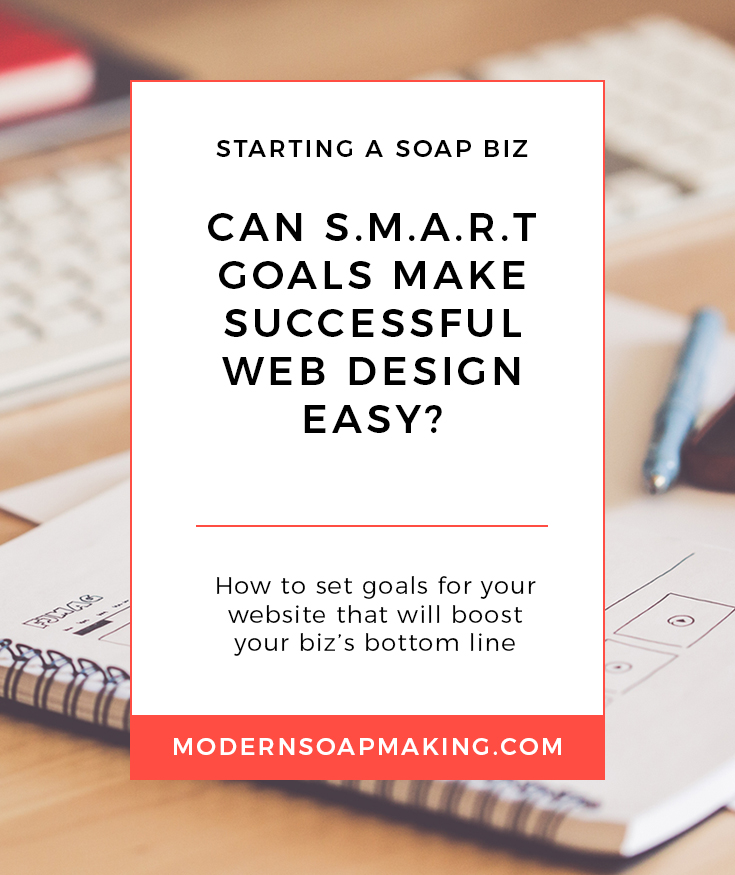Can SMART goals make successful web design easy?

Before you can dive into your web design, either starting from scratch or doing some updates, you need to be crystal clear on what your goals are. And those goals should be all about making your bottom line blast off. Let's talk about how to use SMART goals to make web design a cakewalk.
So, we are here to make sure you keep your eyes on the prize. That means no ego trips, no setting yourself up for failure, and no listening to voices that don't matter.

(Before you can figure out your goals to improve your site's web design, you need to know what elements make a website successful and if yours is missing the mark.)
All right. Let's get started...
Inflate your bottom line, not your ego!
Be objective as you lay out your web design goals, and keep the success of your business foremost in your mind. In addition, stay clear of any goals that you choose for the sake of your vanity rather than your business’s profitability.
(Remember how we told you all of those fancy-pants swirls you wanted to master weren’t a good business move? This is the same kind of thing.)
Lots of people go straight to wanting to boost their pages views. And boosting your page views may make you feel great, but it's not the most meaningful site metric to consider. If visitors are clicking around from page to page but can’t find what they need, it will rack up page views. But, that's not a good thing! It's a huge red flag.
So, instead of focusing on traffic volume, look at your conversions. Do you know how many people who land on your site are taking the action that you want them to take? That’s one of the most effective metrics you can look at. Because that is what will tell you if you are answering your visitors’ pain points and helping them to find what they need.
However, more traffic isn’t going to solve the problem if the problem is that you are not giving your customers the experience they want. Can you imagine a brick-and-mortar trying to get more shoppers in when their cash register is broken? Remember, you have to prioritize your goals to fix the biggest problems you have first.
Don't Set Yourself Up for Failure.
So, how do you set goals that clarify exactly what you need to work on as you design your site (or work to update it)? First, don’t set yourself up for failure by setting too many goals. Three goals is a good, manageable start.
Four common goals that small businesses start with when tackling their site's web design are:
- Increase sales.
Is one of your goals is to increase sales? (I bet it is!) To get that boost, you must ensure an enjoyable e-commerce experience for your customers. As you can guess, customer frustration leads to lost sales. So, create clear calls to action that guide visitors to complete their purchases. And, make the checkout process easy and intuitive! - Improve interaction.
Want to improve interaction? Make it easier for customers to contact you! If you don't have one, add a contact form. Then, make it simple to sign up for a regular newsletter (and make sure you follow up and send it). You might even want to offer live chat or host a webinar. - Become a resource.
To become a resource you need to create content that is helpful for your target market. In addition, make that info easy for them to find. (This one is a top goal here at Modern Soapmaking, and you better believe we planned for it in our new web design.) - Build your brand.
Need to build your brand? We dive deep into that in S2M. So, join Soapmaker to Moneymaker and you will see opportunities to brand your website every step of the way.
Set goals that fit your business needs. Limit them to three so you don’t get overwhelmed before you even start. Then, lay out a plan to accomplish those goals.
It's ALL About Your Perfect Customer
Remember how we talked about setting goals that put your company's success first? Well, as you work through your list, don’t forget that your business’s success hinges on your perfect customer.
If you get feedback on your website, make sure any criticism is coming from your ideal customer before you act on it. If it’s not important to your target market, it’s just noise. So, don’t waste your time!
(Need your own personal guidebook for dealing with other people’s opinions? Lucky you! Get the scoop on how to deal with other people's feedback in business, and know when to take it seriously - or not!)
Get smart with S.M.A.R.T Goals
When it comes to making goals for your site's web design, we subscribe to the S.M.A.R.T goals philosophy.
S.M.A.R.T. goals are:
- S - Specific
- M - Measurable
- A - Attainable
- R - Relevant
- T - Timeboxed
Let’s say one of the three goals you listed is to improve your website’s conversion rate (and that’s a great goal for a small business to have). To make that a S.M.A.R.T. goal, you need to make it specific. “My website’s conversion rate will increase by five percentage points.” That is a specific goal.
Sticking with the conversion rate example, how do we make sure that goal is measurable? Well, we check to see that there is a method available to measure progress. Conversion rates can be measured by website analytics. Consequently, it will be easy to determine if you achieved the growth you set out to.
A goal that is attainable is realistic. If you are averaging ten online sales a month, don’t set a goal to get 2,500 orders next month. That’s a recipe for a freakout. Your big picture goal might be 2,500 orders per month. But, break that down: you want to turn more lookers into buyers this month. In other words, you want to boost conversions. That’s attainable. Freak out averted.
Also, don’t have a goal that doesn’t matter to your business success. Feed your bottom line, not your vanity. Don’t set a goal for page views just so you have bragging rights. Also, don’t waste time making a how-to video to impress your soaping friends. Spend your time where it counts, on things that are relevant to your business and customers.
Timeboxed simply means that your goal has a deadline. That could mean you are going to launch your website in six months. Or, maybe you plan to have that 5 percentage point boost in conversions by the end of the quarter. Make sure the finish line is defined and in sight, so you don’t go off course.
If you put it all together, your goal might be: Increase conversion rates by 5 percentage points by the end of the first quarter of this year as measured by website analytics.
Smart, right?
Name one goal you have for your business in the comments section. And make it S.M.A.R.T.!
Want to snag weekly advice on building a successful soap biz directly in your inbox?
Of course you do! Sign up for our newsletter below for more tips and tricks to make bank in your biz.

